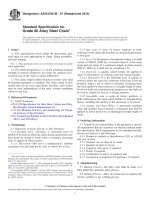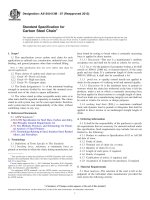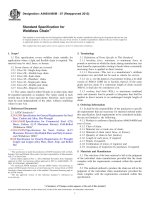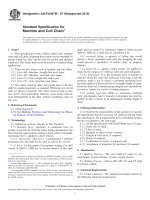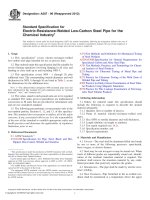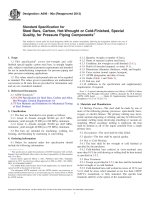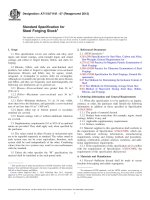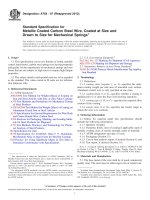Astm a 764 07 (2012)
Bạn đang xem bản rút gọn của tài liệu. Xem và tải ngay bản đầy đủ của tài liệu tại đây (97.98 KB, 5 trang )
Designation: A764 − 07 (Reapproved 2012)
Standard Specification for
Metallic Coated Carbon Steel Wire, Coated at Size and
Drawn to Size for Mechanical Springs1
This standard is issued under the fixed designation A764; the number immediately following the designation indicates the year of
original adoption or, in the case of revision, the year of last revision. A number in parentheses indicates the year of last reapproval. A
superscript epsilon (´) indicates an editorial change since the last revision or reapproval.
This standard has been approved for use by agencies of the Department of Defense.
2.2 U.S. Government Standards:3
Fed. Std. No. 123 Marking for Shipment (Civil Agencies)
MIL-STD-129 Marking for Shipment and Storage
2.3 Automotive Industry Action Group Standard:4
AIAG B-5 02.00 Primary Metals Identification Tag Application Standard
1. Scope*
1.1 This specification covers two finishes of round, metallic
coated, hard-drawn, carbon steel spring wire having properties
and quality for the manufacture of mechanical springs and wire
forms that are not subject to high stress or require high fatigue
properties.
3. Terminology
1.2 The values stated in inch-pound units are to be regarded
as the standard. The values stated in SI units are for information purposes only.
3.1 Definitions:
3.1.1 coating class (regular, 1, or 3)—specifies the minimum coating weight per unit area of uncoated wire surface.
Aluminum coated wire is only specified in one class.
3.1.2 coating finish (1 or 2)—specifies whether a coating is
applied prior to or after the final cold drawing operation.
3.1.3 coating type (A, B, or C)—specifies the required alloy
content of the coating.
3.1.4 tensile class (I or II)—specifies the tensile range to
which the wire is to conform.
2. Referenced Documents
2.1 ASTM Standards:2
A90/A90M Test Method for Weight [Mass] of Coating on
Iron and Steel Articles with Zinc or Zinc-Alloy Coatings
A370 Test Methods and Definitions for Mechanical Testing
of Steel Products
A428/A428M Test Method for Weight [Mass] of Coating on
Aluminum-Coated Iron or Steel Articles
A510 Specification for General Requirements for Wire Rods
and Coarse Round Wire, Carbon Steel
A700 Practices for Packaging, Marking, and Loading Methods for Steel Products for Shipment
A751 Test Methods, Practices, and Terminology for Chemical Analysis of Steel Products
B6 Specification for Zinc
B750 Specification for GALFAN (Zinc-5 % AluminumMischmetal) Alloy in Ingot Form for Hot-Dip Coatings
E29 Practice for Using Significant Digits in Test Data to
Determine Conformance with Specifications
4. Ordering Information
4.1 Orders for material under this specification should
include the following information:
4.1.1 Quantity (weight),
4.1.2 Diameter, finish, class of coating if applicable, type of
metallic coating, class of tensile strength, name of material,
4.1.3 ASTM designation and date of issue,
4.1.4 Packaging (Section 15),
4.1.5 Cast or heat analysis report, if desired (Section 6), and
4.1.6 Test report, if desired (Section 14).
NOTE 1—A typical ordering description is as follows: 30 000 lb 0.120
in. Finish 2, Class 1, Type B Metallic Coating, Tensile Class II, Steel
Mechanical Spring Wire in 400-lb, 22-in. coils to ASTM A764, dated.
5. Materials and Manufacture
1
This specification is under the jurisdiction of ASTM Committee A05 on
Metallic-Coated Iron and Steel Products and is under the direct responsibility of
Subcommittee A05.12 on Wire Specifications.
Current edition approved Sept. 1, 2012. Published October 2012. Originally
approved in 1979. Last previous edition approved in 2007 as A764 – 07. DOI:
10.1520/A0764-07R12.
2
For referenced ASTM standards, visit the ASTM website, www.astm.org, or
contact ASTM Customer Service at For Annual Book of ASTM
Standards volume information, refer to the standard’s Document Summary page on
the ASTM website.
5.1 The base metal of the wire shall be of good commercial
quality steel. The steel may be either ingot cast or strand cast.
3
Available from Standardization Documents Order Desk, Bldg. 4, Section D,
700 Robbins Ave., Philadelphia, PA 19111-5094, ATTN: NPODS.
4
Available from Automotive Industry Action Group, 26200 Lahser Rd., Suite
200, Southfield, MI 48034, www.aiag.org.
*A Summary of Changes section appears at the end of this standard
Copyright © ASTM International, 100 Barr Harbor Drive, PO Box C700, West Conshohocken, PA 19428-2959. United States
1
A764 − 07 (2012)
7.1.1 Requirements—The material as represented by tension
test specimens shall conform to the requirements prescribed in
Table 2 or Table 3 for the various sizes and specified class.
7.1.2 Test Method—The tension test shall be made in
accordance with Test Methods A370, Supplement IV.
5.2 A sufficient discard shall be made to ensure freedom
from injurious piping and undue segregation.
5.3 The wire shall be cold drawn to produce the desired
mechanical properties.
5.4 Each coil shall be of one continuous length. Only welds
made prior to cold drawing are permitted, unless otherwise
agreed upon at the time of the purchase or contract.
7.2 Wrap Test:
7.2.1 Requirement—Finish 1 (drawn to size metallic coated)
wire shall withstand wrapping on a mandrel as shown in Table
4 without the steel base fracturing or the metallic coating
peeling or flaking to such an extent that coating metal can be
removed by rubbing with the bare fingers. Finish 2 (metallic
coated at size) wire shall withstand wrapping on a mandrel as
shown in Table 5 without the steel base fracturing or the
metallic coating peeling or flaking to such an extent that
coating metal can be removed by rubbing with the bare fingers.
Loosening or detachment, during the wrap test, of superficial,
small particles of coating metal formed by mechanical polishing of the metallic coated wire shall not be considered cause for
rejection.
7.2.2 Test Method—The wrap test shall be made in accordance with Test Methods A370, Supplement IV.
5.5 The material shall be metallic coated prior to cold
drawing, or at an intermediate stage of cold drawing (Finish 1),
or shall be metallic coated after the final cold drawing (Finish
2).
5.6 The wire shall be furnished with one of three types of
metallic coating, as specified:
5.6.1 Type A—Aluminum coated (aluminized),
5.6.2 Type B—Zinc coated (galvanized), or
5.6.3 Type C—Zinc-5 % aluminum-mischmetal (Zn-5AlMM) alloy coated.
5.7 Coating Types A and C shall be produced by a hot-dip
process. Coating Type B may be produced by either a hot-dip
or an electrolytic process at the option of the producer.
5.8 The slab zinc for Coating Type B shall be any grade of
zinc conforming to Specification B6.
7.3 Metallic Coating.
7.3.1 Requirement:
7.3.1.1 For metallic coating Type A, the wire shall conform
to the minimum weight of coating prescribed in Table 6.
7.3.1.2 For metallic coating Type B or Type C, the wire shall
conform to the minimum weight of coating for Coating Class
1 or 3 prescribed in Table 7. Regular coating has no minimum
requirement.
7.3.2 Test Methods:
7.3.2.1 The weight of coating test for metallic coating Type
A shall be made in accordance with Test Method A428/
A428M.
7.3.2.2 The weight of coating test for metallic coating Type
B or Type C shall be made in accordance with Test Method
A90/A90M.
5.9 The ingot used for Coating Type C shall conform to
Specification B750.
6. Chemical Requirements
6.1 The steel shall conform to the requirements for chemical
composition prescribed in Table 1.
6.2 Cast or Heat Analysis—Each cast or heat of steel shall
be analyzed by the manufacturer to determine compliance with
the percentage of elements prescribed in Table 1. This analysis
shall be from a test specimen preferably taken during the
pouring of the cast or heat. When required, this shall be
reported to the purchaser.
6.3 Product Analysis—An analysis may be made by the
purchaser from finished wire representing each cast or heat of
steel. The chemical composition thus determined, as to elements required or restricted, shall conform to the product
analysis requirements specified in Table 10 of Specification
A510.
8. Dimensions and Permissible Variations
8.1 The diameter of the wire shall not vary from that
specified by more than the tolerances specified in Table 8 or
Table 9.
6.4 For referee purposes, Test Methods, Practices, and
Terminology A751 shall be used.
9. Workmanship, Finish, and Appearance
9.1 The surface of Finish 1, drawn metallic coated wire,
shall be smooth and free from defects such as seams, pits, die
marks, and other defects tending to impair the use of the wire
for springs.
7. Mechanical Requirements
7.1 Tension Test:
TABLE 1 Chemical Requirements
Element
Composition, %
Carbon
Manganese
Phosphorus, max
Sulfur, max
Silicon
0.45–0.85A
0.30–1.30B
0.040
0.050
0.10–0.35
A
B
9.2 The surface of Finish 2, metallic coated at wire size,
shall be free of slivers, scale, and other defects tending to
impair the use of this wire for springs. The metallic coating
shall be smooth and continuous. If a sample does not demonstrate a smooth and continuous coating, one sample shall be cut
from each end of the coil and examined.
Carbon in any one lot shall not vary by more than 0.13 %.
Manganese in any one lot shall not vary by more than 0.30 %.
9.3 The wire shall be packaged so that it can be unwound in
a trouble-free manner.
2
A764 − 07 (2012)
TABLE 2 Tensile RequirementsA —Finish 1 (Drawn to Size Metallic Coated), Regular or Class 1 Coating (One Class on Coating Type A)
Wire Diameter,B in. (mm)
Tensile Class I
Tensile Class II
Tensile Strength, ksi (MPa)
Tensile Strength, ksi (MPa)
min
0.032
0.035
0.041
0.048
0.054
0.062
0.072
0.080
0.092
0.106
0.120
0.135
0.148
(0.81)C
(0.89)C
(1.04)C
(1.22)C
(1.37)
(1.57)
(1.83)
(2.03)
(2.34)
(2.69)
(3.05)
(3.43)
(3.76)
253
248
242
236
231
225
220
216
209
205
200
196
193
max
(1740)
(1710)
(1670)
(1630)
(1590)
(1550)
(1520)
(1490)
(1440)
(1410)
(1380)
(1350)
(1330)
min
306 (2110)
301 (2080)
293 (2020)
286 (1970)
279 (1920)
272 (1880)
266 (1830)
261 (1800)
253 (1740)
248 (1710)
241 (1660)
237 (1630)
234 (1610)
292
287
279
273
266
259
254
249
241
237
230
226
223
max
(2010)
(1980)
(1920)
(1880)
(1830)
(1790)
(1750)
(1720)
(1660)
(1630)
(1590)
(1560)
(1540)
347
342
332
325
316
308
301
296
287
281
273
269
266
(2390)
(2360)
(2290)
(2240)
(2180)
(2120)
(2080)
(2040)
(1980)
(1940)
(1880)
(1850)
(1830)
A
Tensile strength values for intermediate diameters may be interpolated.
Decimal size is rounded to three significant places in accordance with Practice E29.
C
These sizes are not produced with metallic coating Type A.
B
TABLE 3 Tensile RequirementsA —Finish 2 (Metallic Coated at Size) Regular, Class 1 or Class 3 Coating (One Class on Coating Type A)
Wire Diameter,B in. (mm)
Class I
Class II
Tensile Strength, ksi (MPa)
Tensile Strength, ksi (MPa)
min
0.062
0.072
0.080
0.092
0.106
0.120
0.135
0.148
0.162
0.177
0.192
0.207
0.225
0.250
A
B
C
(1.57)C
(1.83)C
(2.03)
(2.34)
(2.69)
(3.05)
(3.43)
(3.76)
(4.11)
(4.50)
(4.88)
(5.26)
(5.72)C
(6.35)C
max
213 (1470)
209 (1440)
204 (1410)
198 (1370)
194 (1340)
189 (1300)
185 (1280)
183 (1260)
180 (1240)
176 (1210)
173 (1190)
171 (1180)
167 (1150)
164 (1130)
272
266
261
253
248
241
237
234
230
225
221
218
214
210
min
(1880)
(1830)
(1800)
(1740)
(1710)
(1660)
(1630)
(1610)
(1590)
(1550)
(1520)
(1500)
(1480)
(1450)
232
227
223
216
212
206
202
200
196
192
189
186
183
179
(1600)
(1570)
(1540)
(1490)
(1460)
(1420)
(1390)
(1380)
(1350)
(1320)
(1300)
(1280)
(1260)
(1230)
max
291
284
280
271
266
258
254
251
246
241
237
233
230
225
(2010)
(1960)
(1930)
(1870)
(1830)
(1780)
(1750)
(1730)
(1700)
(1660)
(1630)
(1610)
(1590)
(1550)
Tensile strength values for intermediate diameters may be interpolated.
Decimal size is rounded to three significant places in accordance with Practice E29.
These sizes are not produced with metallic coating Type A.
TABLE 4 Mandrel Diameters for Steel Ductility and Adherence of
Metallic Coating Test for Finish 1 Wire (Drawn to Size Metallic
Coated)
Wire Diameter
in.
0.032 to
0.148 incl
11. Number of Tests and Retests
11.1 The number of test specimens taken from the ends of
coils during production to ensure compliance with 7.1, 7.2, and
7.3 varies with the quality control procedures and the manufacturing facilities of each manufacturer, but is generally not
less than 10 % of the coils produced. For the purpose of final
product testing, one specimen from every ten coils, or a
fraction thereof, in a lot shall be selected at random, or a total
of seven specimens, whichever is less.
Mandrel Diameter
mm
Class I
Tensile
Class II
Tensile
0.81 to 3.76
incl
1DA
2D
A
D equals nominal wire diameter being tested. For 1D mandrel, wire may be
wound on itself.
11.2 Should one or more of the wire specimens fail any
requirement, the lot shall be subjected to retest. For retest
purposes the original lot shall be regrouped into 50 coil lots or
fractions thereof. Each lot shall be tested for the property in
which the original sample failed to comply at a frequency of
10 % or more so that the total number of tests is at least double
the original. Any lot that exhibits a failure shall be rejected.
The manufacturer may test each coil in the failed lot for the
property in which failure occurred and reject only the nonconforming coils.
10. Sampling
10.1 A lot shall consist of all of the coils of wire of the same
size, type of coating, tensile strength class, metallic coating
type, finish, and heat or cast offered for inspection at one time.
A wire sample of sufficient length, approximately 4 ft (1.2 m),
shall be cut from either end of each coil selected for tests
described in 7.1, 7.2, and 7.3.
3
A764 − 07 (2012)
TABLE 5 Mandrel Diameters for Steel Ductility and Adherence of Metallic Coating Test for Finish 2 Wire (Metallic Coated at Size)
Wire Diameter
Mandrel Diameters for Various Coating and Tensile Strength Classes
Regular and Class I Coating
in.
0.062
0.076
0.148
0.162
A
to
to
to
to
under 0.076
under 0.148
under 0.162
0.250 incl
Class 3 Coating
mm
Class I Tensile
Class I Tensile
Class I Tensile
Class II Tensile
1.57 to under 1.93
1.93 to under 3.76
3.76 to under 4.11
4.11 to 6.35 incl
1DA
2D
2D
3D
2D
3D
4D
5D
2D
3D
4D
4D
3D
4D
5D
5D
D equals nominal wire diameter being tested.
TABLE 6 Minimum Weight of Aluminum per Unit Area of
Uncoated Wire Surface
Wire Diameter,A
in. (mm)
0.054
0.062
0.072
0.076
0.080
0.092
0.099
0.106
0.120
0.135
0.148
0.162
0.177
0.192
0.207
(1.37)
(1.57)
(1.83)
(1.93)
(2.03)
(2.34)
(2.51)
(2.69)
(3.05)
(3.43)
(3.76)
(4.11)
(4.50)
(4.88)
(5.26)
Finish 1
TABLE 8 Permissible Variations in Dimensions Finish 1, Drawn
to Size Metallic CoatedA
Wire Diameter, in. (mm)
Finish 2
oz/ft2
g/m2
oz/ft2
g/m2
0.20
0.20
0.20
0.21
0.21
0.21
0.23
0.23
0.23
0.25
0.25
0.27
0.27
0.30
0.30
61
61
61
64
64
64
70
70
70
70
70
82
82
92
92
...
...
...
...
0.30
0.32
0.32
0.35
0.35
0.35
0.40
0.40
0.40
0.40
0.40
...
...
...
...
92
98
98
107
107
107
122
122
122
122
122
0.032 (0.81) to under
0.076 (1.93)
0.076 (1.93) to 0.148
(3.76) incl
0.032
0.035
0.041
0.048
0.054
0.062
0.072
0.076
0.080
0.092
0.099
0.106
0.120
0.135
0.148
0.162
0.177
0.192
0.207
0.225
0.250
(0.81)
(0.89)
(1.04)
(1.22)
(1.37)
(1.57)
(1.83)
(1.93)
(2.03)
(2.34)
(2.51)
(2.69)
(3.05)
(3.43)
(3.76)
(4.11)
(4.50)
(4.88)
(5.26)
(5.72)
(6.35)
Class 1 Coating
oz/ft2
g/m2
0.05
0.10
0.10
0.15
0.15
0.15
0.15
0.20
0.25
0.30
0.30
0.30
0.30
0.30
0.40
0.40
0.40
0.50
0.65
0.65
0.65
16
31
31
46
46
46
46
61
76
92
92
92
92
92
122
122
122
153
198
198
198
0.25
0.40
0.40
0.40
0.40
0.50
0.50
0.60
0.65
0.70
0.80
0.80
0.80
0.80
0.80
0.80
0.80
0.90
0.90
0.90
0.90
76
122
122
122
122
153
153
183
198
214
244
244
244
244
244
244
244
275
275
275
275
0.002 (0.05)
0.002 (0.05)
Wire Diameter, in. (mm)A Tolerance,B Plus and Minus, in. (mm)
0.062 (1.57) to under
0.076 (1.93)
0.076 (1.93) to 0.250
(6.35) incl
Regular and Class I
Coating
Class 3 Coating
0.002 (0.05)
0.002 (0.05)
0.003 (0.08)
0.004 (0.102)
A
For the purpose of determining conformance with this specification, an observed
value shall be rounded to the nearest 0.001 in. (0.03 mm) in accordance with the
rounding method of Practice E29.
B
It is recognized that the surfaces of hot dipped metallic coatings are not perfectly
smooth and devoid of irregularities. If the tolerances shown above are rigidly
applied to such irregularities that are inherent to the product, unjustified rejections
of wire that would actually be satisfactory for use could occur. Therefore, it is
intended that these tolerances be used in gaging the uniform areas of the metallic
coated wire.
Class 3 Coating
g/m2
0.001 (0.03)
TABLE 9 Permissible Variations in Dimensions Finish 2, Metallic
Coated at Size
TABLE 7 Minimum Weight of Zinc or Zinc-5 % AluminumMischmetal Alloy per Unit Area of Uncoated Wire Surface
oz/ft2
0.001 (0.03)
A
For purposes of determining conformance with this specification, all specified
limits are absolute as defined in Practice E29.
A
Diameters, other than those shown above, are produced with aluminum coating
equivalent to those of the next smaller size.
Wire Diameter,A
in. (mm)
Permissible Variations, Permissible Out-of-Round,
Plus and Minus, in. (mm)
in. (mm)
12. Inspection
12.1 Unless otherwise specified in the contract or purchase
order, the manufacturer is responsible for the performance of
all inspection and test requirements specified in this specification. Except as otherwise specified in the contract or purchase
order, the manufacturer may use his own or any other suitable
facilities for the performance of the inspection and test
requirements unless disapproved by the purchaser at the time
the order is placed. The purchaser shall have the right to
perform any of the inspections and tests set forth in this
specification when such inspections and tests are deemed
necessary to ensure that the material conforms to prescribed
requirements.
A
Diameters, other than those shown above, are produced with metallic coating
equivalent to those of the next smaller size.
13. Rejection and Rehearing
13.1 Unless otherwise specified, any rejection based on tests
made in accordance with this specification shall be reported to
the manufacturer within a reasonable length of time after
receipt of the material.
11.3 If any test specimen exhibits obvious imperfections
due to cutting a sample from the coil or due to handling
damage after the sample has been cut, it may be discarded and
another specimen substituted.
4
A764 − 07 (2012)
13.2 The material must be adequately protected and correctly identified in order that the producer may make a proper
investigation.
15.3 Unless otherwise specified in the purchaser’s order,
packaging, marking, and loading for shipments shall be in
accordance with those procedures outlined in Practices A700.
14. Certification
15.4 When specified in the contract or order, and for direct
procurement by or direct shipment to the U.S. Government,
marking for shipment, in addition to requirements specified in
the contract or order, shall be in accordance with MIL-STD129 for U.S. Military Agencies and in accordance with Fed.
Std. No. 123 for U.S. Government Civil Agencies.
14.1 When specified on the purchase order or contract, a
manufacturer’s or supplier’s certification shall be furnished to
the purchaser that the material was manufactured, sampled,
tested, and inspected in accordance with this specification and
has been found to meet the requirements. When specified in the
purchase order or contract, a report of the test results shall be
furnished.
15.5 Bar Coding—In addition to the previously stated identification requirements, bar coding is acceptable as a supplementary identification method. Bar coding should be consistent
with AIAG Standard 02.00. The bar code may be applied to a
substantially affixed tag.
14.2 The certification shall include the specification
number, year date of issue, and revision letter, if any.
15. Packaging, Marking, and Loading
15.1 The coil weight, dimensions, and method of packaging
shall be agreed upon between the manufacturer and the
purchaser.
16. Keywords
16.1 aluminized; galvanized; mechanical springs; springs;
steel wire; wire; wire forms; zinc-5 % aluminum-mischmetal
alloy coated
15.2 The size of wire, ASTM specification, finish, coating
class, coating type, tensile class, and name or mark of the
manufacturer shall be shown on a tag securely attached to each
package of wire.
SUMMARY OF CHANGES
Committee A01 has identified the location of selected changes to this standard since the last issue
(A764 – 95(2001)) that may impact the use of this standard. (Approved 03/01/2007.)
(1) Removed references to MIL-STD-163.
(2) Completed 5-year review.
ASTM International takes no position respecting the validity of any patent rights asserted in connection with any item mentioned
in this standard. Users of this standard are expressly advised that determination of the validity of any such patent rights, and the risk
of infringement of such rights, are entirely their own responsibility.
This standard is subject to revision at any time by the responsible technical committee and must be reviewed every five years and
if not revised, either reapproved or withdrawn. Your comments are invited either for revision of this standard or for additional standards
and should be addressed to ASTM International Headquarters. Your comments will receive careful consideration at a meeting of the
responsible technical committee, which you may attend. If you feel that your comments have not received a fair hearing you should
make your views known to the ASTM Committee on Standards, at the address shown below.
This standard is copyrighted by ASTM International, 100 Barr Harbor Drive, PO Box C700, West Conshohocken, PA 19428-2959,
United States. Individual reprints (single or multiple copies) of this standard may be obtained by contacting ASTM at the above
address or at 610-832-9585 (phone), 610-832-9555 (fax), or (e-mail); or through the ASTM website
(www.astm.org). Permission rights to photocopy the standard may also be secured from the ASTM website (www.astm.org/
COPYRIGHT/).
5

